Search Images
Browse Content (p. 894)

Image
Roman Aqueduct, Lesbos
The Roman aqueduct on the Greek island of Lesbos. Located near the village of Moría and intended to bring water to the city-state of Mytilene. Built around 200 BCE.
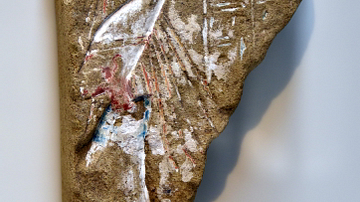
Image
Amenhotep IV at His Jubilee
This fragment of a relief depicts the Egyptian pharaoh Amenhotep IV (r. 1353-1336 BCE later known as Akhenaten) at his Jubilee. He stands below the rays of god Aten and wears the White Crown of Upper Egypt. Painted sandstone. New Kingdom...

Image
Later Form of Aten Cartouches
Three cartouches from House 47.10 at Amarna, Egypt. New Kingdom, 18th Dynasty, c. 1340 BCE. The one on the left, smaller than the other two, is the prenomen (throne name) cartouche of the Egyptian pharaoh Akhenaten (r. 1353-1336 BCE) and...
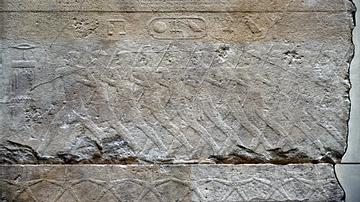
Image
Cartouche of Sahure
This is a detail of a larger limestone relief, which came from the Mortuary Temple of Pharaoh Sahure (25th Century BCE) at Abusir, Egypt. The cartouche of Sahure (his name means "He who is close to Re") can be seen above a procession of warriors...
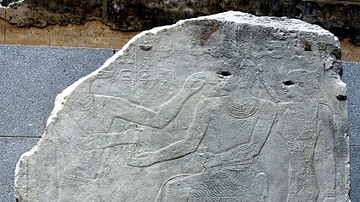
Image
Temple Relief of Nyuserre
This limestone relief came from the Mortuary Temple of the pharaoh Nyuserre Ini (late 25th Century BCE) at Abusir, Egypt. Nyuserre is protected by the Wadjet and receives life from Anubis. Nyuserre was the 6th ruler of the 5th Dynasty. Old...
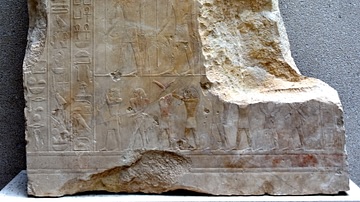
Image
Relief from the Pyramid of Sahure
This large fragment came from the Pyramid of Pharaoh Sahure (25th Century BCE) at Abusir, Egypt. Four registers can be recognized. The gods Seth and Sopdu present captives or prisoners to Sahure; Sahure was the 2nd ruler of the 5th Dynasty...
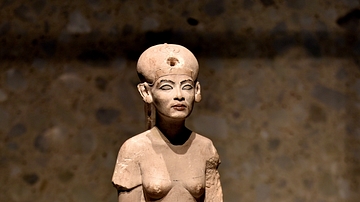
Image
Statue of Nefertiti
Limestone standing/striding figure of the Egyptian Queen Nefertiti (c. 1370 - c. 1336 BCE), the Great Royal Wife of Akhenaten (r. 1353-1336 BCE). New Kingdom, 18th Dynasty, c. 1345 BCE. From Amarna, Egypt. It is on display at the Neues Museum...
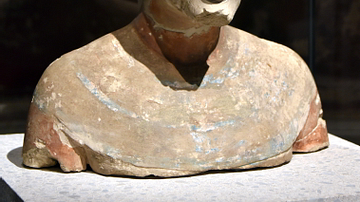
Image
Bust of Akhenaten from Amarna
This bust of the Egyptian pharaoh Akhenaten (r. 1353-1336 BCE) came from House P 47.2, Room 19 at the city of Amarna, Egypt. Limestone (with additions), painted and gilded. New Kingdom, 18th Dynasty, c. 1340 BCE. Donated by James Simon (1851...
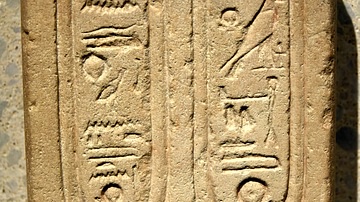
Image
Early Cartouches of Aten
Limestone "early" cartouches of the god Aten. The one on the right reads "The living Re-Horakhty, Rejoicing in the horizon" while that on the left reads "In his name as Shu, who is in the Aten". From small houses, N 49.06, at Amarna, Egypt...
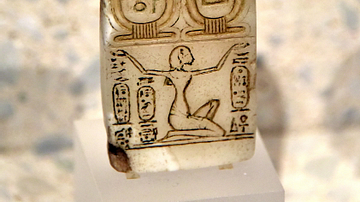
Image
Early Cartouche of the God Aten
Early cartouche of the god Aten, calcite alabaster. New Kingdom of Egypt, 18th Dynasty, 1351-1334 BCE. At the upper part of this votive plaque of the God Aten, there are two "early" cartouches of Aten. On the right, it reads "The living...